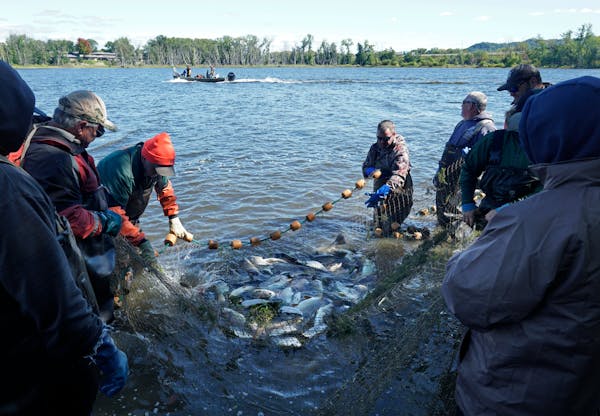The cicadas are coming — and if you're in the Midwest or the Southeast, they will be more plentiful than ever. Or at least since the Louisiana Purchase.
This spring, for the first time since 1803, two cicada groups known as Brood XIX, or the Great Southern Brood, and Brood XIII, or the Northern Illinois Brood, are set to appear at the same time, in what is known as a dual emergence.
The last time the Northern Illinois Brood's 17-year cycle aligned with the Great Southern Brood's 13-year period, Thomas Jefferson was president. After this spring, it'll be another 221 years before the broods, which are geographically adjacent, appear together again.
"Nobody alive today will see it happen again," said Floyd W. Shockley, an entomologist and collections manager at the Smithsonian National Museum of Natural History. "That's really rather humbling."
These insects will begin to appear in late April. They'll use their forelegs to tunnel out from the earth, their beady red eyes looking for a spot where they can peacefully finish maturing. A few days after they emerge and molt, the males will start buzzing in an effort to find a mate, a slow-building crescendo of noise that in a chorus can be louder than a plane.
Shockley said the dual emergence would most likely result in more than 1 trillion cicadas appearing in the roughly 16-state area where the two broods are generally seen. Forested areas, including urban green spaces, will have higher numbers than will agricultural regions. To put that into perspective, 1 trillion cicadas, each of which are just over an inch long, would cover 15,782,828 miles if they were laid end-to-end.
"That cicada train would reach to the moon and back 33 times," he said.
One of the more exciting aspects of this dual emergence, Shockley said, lies in the possibility of interbreeding along the narrow band in northern Illinois where the two broods will overlap.
"Under just the right circumstances and with just the right number of individuals cross breeding," he said, "you have the possibility of the creation of a new brood set to a new cycle. This is an extremely rare event."
In most cases, Shockley said, the cicadas, which live about a month, will die not far from where they had emerged. But since they're not great at flying and even worse at landing, cicadas often end up on sidewalks and city streets, where they can be squished by people or cars and "could conceivably make things slick."
"In urban areas, there will be sufficient numbers to necessitate removal of their bodies," he said. "But rather than throwing in the trash or cleaning up with street sweepers, people should consider them basically free fertilizer for the plants in their gardens and natural areas."
According to the University of Illinois Urbana-Champaign, during a 1990 cicada emergence, "there were reports from people in Chicago having to use snow shovels to clear their sidewalks of the dead cicadas."
The first wave of periodical cicadas, which differ from those that appear annually in smaller numbers, will show up in northern Louisiana, southern Arkansas, Alabama, Mississippi, northern Georgia, and up into western South Carolina, said Gene Kritsky, a retired professor of biology at Mount St. Joseph University in Cincinnati, and the author of several books on cicadas, including "A Tale of Two Broods," which was published this month.
Then it'll be central North Carolina, eastern Tennessee and northern Arkansas, followed by southern Missouri, southern Illinois and western Kentucky. Finally, he said, the cicadas will appear throughout central and northern Missouri and Illinois, northwestern Indiana, southern Wisconsin and eastern Iowa.
All told, these areas will be buzzing for about six weeks as the insects fly around looking to mate and deposit their eggs into slits they cut into tree branches. Then they'll die, bringing with them an unforgettable smell, described by Shockley as similar to rotting nuts, as their bodies decay.
The insects are clumsy flyers, making them easy prey for predators like birds. They don't bite, sting or carry any diseases, and they serve as natural tree gardeners.
The holes they leave behind help aerate the soil and allow for rainwater to get underground and nourish tree roots in hot summer months. The slits they make in trees can cause some branches to break, and the leaves then turn brown in a process known as "flagging." But it's like a natural pruning, and when the tree grows the branch again, the fruit will be larger. The cicadas' rotting bodies provide nutrients that trees need.
"They're very important to the ecosystem in the eastern deciduous forest," Kritsky said, referring to the forest ecosystem in the eastern half of the country.
John R. Cooley, a biology professor at the University of Connecticut, said his best advice for people living in the regions of the dual emergence is to let the bugs be.
"The forest is where they live," he said. "They are a part of the forest. Don't try to kill them. Don't try to spray insecticide, all that kind of thing. That's just going to end badly because there are more than you could possibly kill with insecticide, you'd end up killing everything."
If you have delicate plants you want to protect, Cooley said, use special netting created for that purpose.
While the prospect of the 1 trillion cicadas that the dual emergence is expected to bring might sound horrifying to some, Shockley emphasized the awe of this rare natural event.
"Don't be scared of it, embrace it for the wondrous event that it is and embrace the fact that it's very temporary," he said. "It will be intense, but short-lived."

How my two daughters, 7 and 10, achieved 'fossil finder' status in Badlands National Park

Minnesota History: Mayo Clinic physician-scientist forged cardiovascular breakthroughs in flight, space

Crisscrossing White Bear Lake, archaeologists search for wrecks — and history
CrowdStrike tech outage cost Delta half a billion dollars, airline's CEO says

